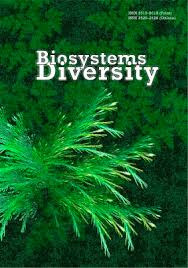Phytoplankton succession in the anthropogenic and climate ecological transformation of freshwater ecosystems
Phytoplankton succession in the anthropogenic and climate ecological transformation of freshwater ecosystems
Author(s): Y. S. Shelyuk, L. Y. AstahovaSubject(s): Energy and Environmental Studies, Sociobiology
Published by: Дніпропетровський національний університет імені Олеся Гончара
Keywords: algae; diversity; freshwater ecosystems; climate change; biological invasion;
Summary/Abstract: The study is focused on the influence of mechanisms of anthropogenic activity and climate changes of different types and levels on the autotrophic link of freshwater ecosystems. The studies of the river, lake, water reservoir and quarry phytoplankton in the territory of the Ukrainian Polissia were carried out during 2005–2019 according to the standard methods. At the same time, we determined water hydrophysical and hydrochemical characteristics. Exactly 812 algal species represented by 877 infraspecific taxa were identified, including 75 new ones for the Ukrainian Polissia, with a significant share of thermophiles and halophiles. The dominance of Chlorophyta, Bacillariophyta, Euglenozoa and Cyanobacteria was observed in all types of water bodies. With the increase in the nutrient content in the composition of dominant complexes of river ecosystems, the role of centric diatoms Cyclotella meneghiniana, C. stelligera, Stephanodiscus hantzschii increased. The vegetation intensity of Aphanizomenon flos-aquae increased in the water courses with partially regulated flow, while vegetation of Chrysococcus rufescens, Pseudokephyrion pillidium, Kephyrion ovum intensified in rivers with increased colour of water. Water reservoirs are dominated by representatives of Bacillariophyta, Cyanobacteria, Euglenozoa, Miozoa, mostly by Aphanizomenon flos-aquae and Peridinium cinctum. The lowest number of dominant species was identified in the lakes, and belonged to the genera Trachelomonas, Peridinium, Chlamydomonas, Crucigeniella, Cyclotella, Aulacoseira. The dominant species in quarries were Cyclotella meneghiniana, Chlamydomonas monadina, Ch. globosa, Coelastrum microporum, Gomphosphaeria aponina, Trachelomonas volvocina and Microcystis aeruginosa. The obtained data can be used to predict scenarios of changes in the autotrophic link under the influence of natural and anthropogenic factors, to develop methods for monitoring and managing ecosystems at different levels of anthropogenic transformation necessary to ensure an appropriate level of their functions and ecological services.
Journal: Biosystems Diversity
- Issue Year: 29/2021
- Issue No: 2
- Page Range: 119-128
- Page Count: 10
- Language: English

